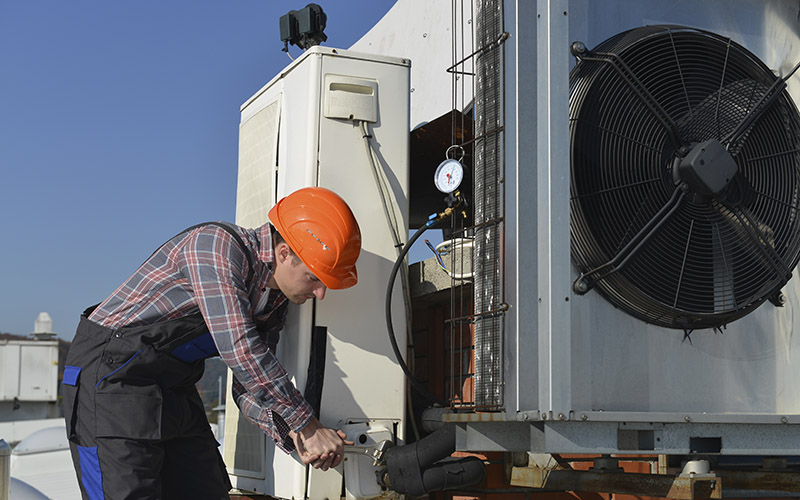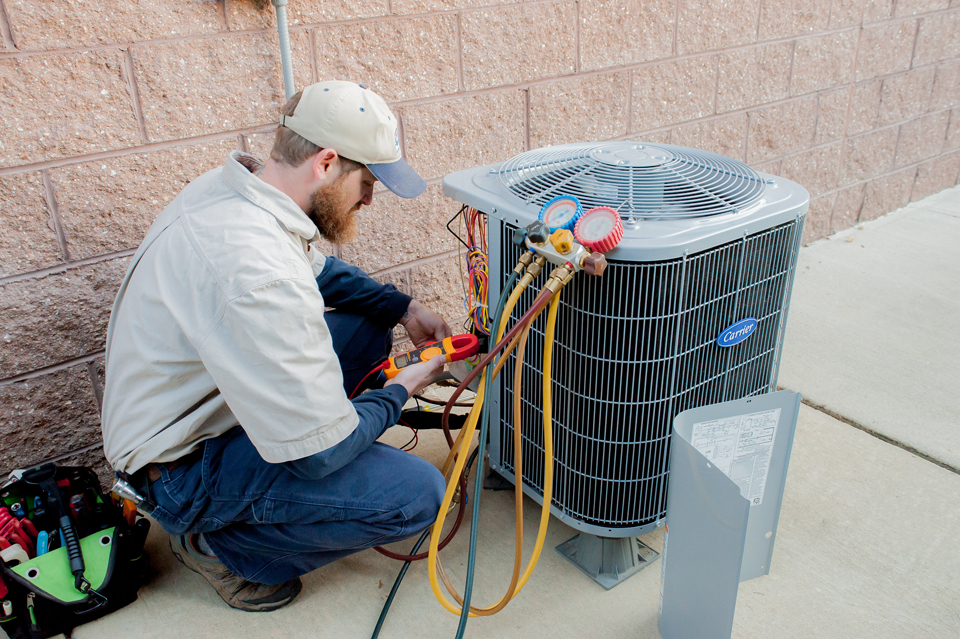Top Approaches for Enhancing Comfort with ductless mini splits
Top Approaches for Enhancing Comfort with ductless mini splits
Blog Article
Just How a Warm Pump and Heating System Collaborate to Optimize Your Home's Heating Efficiency
Recognizing exactly how a warm pump and heater work with each other is vital for property owners seeking reliable heating services. Each system has its toughness, offering a well balanced method to home convenience. The heatpump excels in modest temperatures, while the heater supplies rapid heat during severe cold. This synergy not just lowers power costs but likewise improves the lifespan of both devices. What variables influence this collaboration, and how can house owners optimize their benefits?
Recognizing Warmth Pumps: Just How They Work
Numerous individuals may be unfamiliar with their inner functions, heat pumps play an important function in modern-day home heating systems. These gadgets run by transferring warmth from one location to one more, utilizing the principles of thermodynamics. In colder months, a warmth pump essences heat from the outdoors air, ground, or water, and transfers it inside your home to warm up the home. On the other hand, during warmer months, it can reverse the procedure, serving as an ac system by removing heat from inside to the outside.Heat pumps contain an evaporator, growth, condenser, and compressor shutoff. The refrigerant within the system soaks up warmth as it vaporizes at low temperatures and pressures. The compressor then raises the stress and temperature level of the refrigerant, permitting it to release warm as it condenses. This efficient process can considerably minimize power consumption contrasted to conventional heating methods, making heatpump a lasting choice for environment control in homes.
The Duty of Furnaces in Home Home Heating
Furnaces play a crucial duty in home heating by providing a trustworthy source of warmth during the chillier months. They operate by generating warmth through combustion or electric resistance, distributing it throughout the home by means of air ducts or radiant systems. The efficiency of a furnace is typically gauged by its Annual Fuel Utilization Performance (AFUE) ranking, which shows exactly how successfully the system transforms gas right into heat.Furnaces can make use of different energy resources, consisting of natural gas, gas, oil, or electrical power, permitting home owners to select one of the most ideal option for their requirements. Unlike heatpump, which might struggle in severe cold, heating systems keep regular efficiency, guaranteeing that interior temperature levels remain comfy regardless of outside conditions. In addition, contemporary heating systems often come equipped with sophisticated modern technology, such as clever thermostats and variable-speed blowers, enhancing their performance and responsiveness. This adaptability makes heaters an essential element in all-encompassing home heating strategies.

Advantages of Using Both Equipments Together
Incorporating the staminas of both heating systems and warm pumps can cause a much more reliable and effective home heating solution. Using both systems permits homeowners to benefit from the warm pump's energy efficiency during milder temperatures while depending on the heater for more severe cold conditions. This twin method can significantly reduce energy expenses, as heatpump take in much less electrical energy than conventional heating methods when temperatures are moderate.Additionally, using both systems with each other can improve comfort levels in the home. Heatpump can provide consistent, even home heating, while heating systems can quickly increase ambient temperature levels when needed. The assimilation of both systems can expand the life-span of tools by lowering wear and tear on each unit, as they share the work. Inevitably, home owners can take pleasure in a well balanced, cost-effective heating solution that changes flawlessly to differing climate condition, making certain a cozy and welcoming home throughout the cold weather.
How Warm Pumps and Furnaces Enhance Each Various Other
They develop a corresponding home heating system that maximizes effectiveness and convenience when homeowners incorporate heat pumps and heaters. Heat pumps operate by transferring warmth from the outdoors air or ground, making them extremely effective in modest climates. They succeed throughout milder temperature levels, offering affordable home heating. On the other hand, heaters produce heat through burning or electrical resistance, delivering strong, instant heat during severe chilly conditions.The combination of these two systems enables dynamic changes based upon temperature changes. Throughout warmer months or milder wintertime days, the warmth pump can take the lead, conserving power and decreasing expenses. As temperature levels decline, the furnace can effortlessly involve, making sure consistent heat throughout the home. This harmony not only optimizes energy use but also improves the life expectancy of both systems, as each system operates within its perfect efficiency array. Together, they create a balanced environment that adjusts to differing climate needs.
Maximizing Efficiency: Tips for Homeowners
House owners can improve their home heating efficiency through several sensible approaches. Establishing a routine upkeep schedule, incorporating clever thermostat innovation, and implementing efficient insulation and securing services are vital actions. These actions not just boost comfort but additionally decrease energy prices.
Regular Maintenance Set Up
To assure maximum heating a knockout post effectiveness, establishing a normal maintenance schedule is necessary for any type of home. Homeowners ought to prioritize regular examinations of both heatpump and furnaces to determine peak performance. This consists of altering air filters every one to three months, as clogged filters can significantly decrease efficiency. Furthermore, organizing expert upkeep a minimum of annually allows specialists to identify and deal with possible problems prior to they rise. House owners should additionally clean the heatpump's outside unit to stop debris buildup that can impede airflow. By sticking to a normal maintenance routine, home owners not just improve their heater' efficiency yet also prolong their life expectancy, causing better comfort and lowered power costs throughout the chillier months.
Smart Thermostat Assimilation
Integrating a smart thermostat into a home heating system can significantly enhance power efficiency, especially as it permits for specific control over temperature level setups. These devices can learn the property owner's routine and choices, instantly readjusting the temperature to optimize comfort while minimizing energy use. They can decrease home heating during times when the home is unoccupied, minimizing unneeded consumption. Many smart thermostats likewise supply real-time power usage information, enabling homeowners to make informed decisions about their heating behaviors. In addition, remote accessibility through smart device apps allows users to readjust settings from anywhere, making certain the home is warm upon return. In general, clever thermostat assimilation not only boosts convenience but significantly adds to power savings and efficiency.
Insulation and Sealing Solutions
Smart thermostats play an essential function in power efficiency, but their efficiency can be significantly boosted by appropriate insulation and securing remedies. Property owners should focus on insulating attics, floors, and walls to minimize warm loss. High-grade insulation products, such as spray foam or fiberglass, can considerably improve thermal resistance. In addition, securing spaces around air ducts, doors, and windows stops chilly air infiltration and heat retreat. Weatherstripping and caulking work methods for dealing with these leaks - heat pump service. Normal evaluations for air leaks, together with making use of blower door examinations, can aid recognize trouble areas. By purchasing insulation and sealing, home owners can maximize the efficiency of their heater, inevitably bring about reduced power consumption and reduced energy bills
Common Misconceptions Regarding Warmth Pumps and Furnaces
What mistaken beliefs border warmth pumps and furnaces? Numerous people wrongly believe that heatpump are ineffective in colder climates. Actually, contemporary heatpump are designed to run effectively also in low temperatures, providing trusted heating throughout winter season. One more common misconception is that heaters are constantly extra effective than heatpump. Nevertheless, this depends on the particular energy resources and effectiveness scores of the devices concerned. Some More Bonuses might likewise assume that making use of both systems concurrently is unnecessary, however in fact, this mix can maximize home heating effectiveness, especially throughout extreme weather. In addition, individuals often think that warmth pumps need consistent maintenance, when truthfully, they have comparable upkeep needs to standard heater. By exposing these myths, property owners can make even more informed decisions regarding their home heating choices, eventually resulting in enhanced comfort and energy efficiency in their homes.
Maintenance Considerations for Combined Solutions

Regularly Asked Questions
Can Heat Pumps Work Properly in Extremely Cold Climates?
Warmth pumps can have a hard time in very cool climates because of lowered effectiveness and warm extraction restrictions. Innovations in modern technology have led to versions developed for better efficiency in such problems, improving their practicality in harsh settings.
The Length Of Time Do Heat Pumps and Furnaces Typically Last?
Heatpump typically last 15 to twenty years, while heating systems have a life-span of 15 to three decades. Normal upkeep can expand their durability, making certain reliable operation and minimizing the need for early substitutes.

What Is the Ordinary Expense of Setting Up Both Solutions?
The average expense of mounting both a warm pump and a heating system generally ranges in between $5,000 to $10,000 - ductless mini splits. Variables influencing this expense consist of system dimension, setup intricacy, and local labor rates
Are There Tax Rewards for Using Energy-Efficient Home Heating Solutions?
Numerous house owners inquire regarding tax rewards for energy-efficient heater. Numerous federal and state programs frequently provide debts or discounts, urging the adoption of sustainable innovations to minimize power usage and advertise environmental responsibility.
How Do I Choose the Right Size Warm Pump and Heating System?
Choosing the appropriate size heatpump and furnace entails computing the home's square footage, considering insulation quality, and examining local climate. Consulting a professional can assure excellent system efficiency and energy effectiveness based on specific demands. heat pump service. Comprehending exactly how a warm pump and heating system job with each other is vital for house owners looking for efficient home heating remedies. In cooler months, a warmth pump extracts heat from the outdoors air, ground, or water, and transfers it indoors to warm up the living room. When home owners incorporate warmth pumps and furnaces, they produce a complementary home heating system that takes full advantage of performance and comfort. Warmth pumps operate by transferring heat from the outdoors air or ground, making them very effective in modest environments. Heat pumps can struggle in exceptionally cold environments due to lowered efficiency and warm removal limitations
Report this page